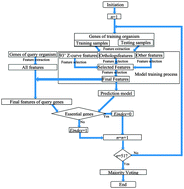Abstract
An effective linear method, ZUPLS, was developed to improve the accuracy and speed of prokaryotic essential gene identification. ZUPLS only uses the Z-curve and other sequence-based features. Such features can be calculated readily from the DNA/amino acid sequences. Therefore, no well-studied biological network knowledge is required for using ZUPLS. This significantly simplifies essential gene identification, especially for newly sequenced species. ZUPLS can also select necessary features automatically by embedding the uninformative variable elimination tool into the partial least squares classifier. No optimized modelling parameters are needed. ZUPLS has been used, herein, to predict essential genes of 12 remotely related prokaryotes to test its performance. The cross-organism predictions yielded AUC (Area Under the Curve) scores between 0.8042 and 0.9319 by using E. coli genes as the training samples. Similarly, ZUPLS achieved AUC scores between 0.8111 and 0.9371 by using B. subtilis genes as the training samples. We also compared it with the best available results of the existing approaches for further testing. The improvement of the AUC score in predicting B. subtilis essential genes using E. coli genes was 0.13. Additionally, in predicting E. coli essential genes using P. aeruginosa genes, the significant improvement was 0.10. Similarly, the exceptional improvement of the average accuracy of M. pulmonis using M. genitalium and M. pulmonis genes was 14.7%. The combined superior feature extraction and selection power of ZUPLS enable it to give reliable prediction of essential genes for both Gram-positive/negative organisms and rich/poor culture media.


 Please wait while we load your content...
Please wait while we load your content...